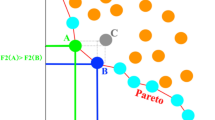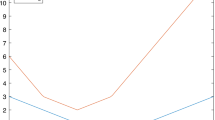Abstract
In this paper, we present a new trust region algorithm for a nonlinear bilevel programming problem by solving a series of its linear or quadratic approximation subproblems. For the nonlinear bilevel programming problem in which the lower level programming problem is a strongly convex programming problem with linear constraints, we show that each accumulation point of the iterative sequence produced by this algorithm is a stationary point of the bilevel programming problem.
Similar content being viewed by others
References
Colson, B., Marcotte P., Savard, G. A trust-region method for nonlinear bilevel programming: Algorithm and computation experience. Comput. Optimiz. App., 30: 211–227 (2005)
Colson, B., Marcotte P., Savard, G. An overview of bilevel optimization. Ann. Oper. Res., 153: 235–256 (2007)
Dempe, S. Foundations of Bilevel Programming. Kluwer Academic, Dordrecht, 2002
Dempe, S., Dutta, J. Is bilevel programming a special case of a mathematical program with complementarity constraints? Math. Program., 131: 37–48 (2012)
Dennis, J.E., Li, S.B., Tapia, R.A. A unified approach to global convergence of trust region methods for nonsmooth optimization. Math. Program., 68: 319–346 (1995)
Kojima, M. Strongly stable stationary solutions in nonlinear programs. In: Analysis and Computation of Fixed Points, ed. by Robinson, S.M., Academic Press, New York, 93–138, 1980
Lou, Z.Q., Pang, J.S., Ralph, D. Mathematical Programs with Equilibrium Constraints. Cambridge: Cambridge University Press, 1996
Marcottea, P., Savardb, G., Zhu, D.L. A trust region algorithm for nonlinear bilevel programming. Oper. Res. Lett., 29: 171–179 (2001)
Pang, J.S., Han, S.H., Rangaraj, N. Minimization of locally Lipschitzian functions. SIAM J. Optimiz., 1: 57–82 (1991)
Qi, L., Sun, J. A trust region algorithm for minimization of locally Lipschitzian functions. Math. Program., 66: 25–43 (1994)
Ralph, D., Dempe, S. Directional derivatives of the solution of a parametric nonlinear program. Math. Program., 70: 159–172 (1995)
Vicente, L.N., Calamai, P.H. Bilevel and multilevel programming: a bibliography review. J. Global Optim., 3: 291–306 (1994)
Yuan, Y. Conditions for convergence of trust region algorithms for nonsmooth optimization. Math. Program., 31: 220–228 (1985)
Zhu, Z.B., Jian, J.B., Zhang, C. An SQP algorithm for mathematical programs with nonlinear complementarity constraints. Appl. Math. Mech. Engl., 30: 659–668 (2009)
Author information
Authors and Affiliations
Corresponding authors
Additional information
Supported by the National Natural Science Foundation of China (No. 11171348, 11171252 and 71232011).
Rights and permissions
About this article
Cite this article
Liu, Gs., Xu, Sq. & Han, Jy. A trust region algorithm for solving bilevel programming problems. Acta Math. Appl. Sin. Engl. Ser. 29, 491–498 (2013). https://doi.org/10.1007/s10255-013-0231-5
Received:
Revised:
Published:
Issue Date:
DOI: https://doi.org/10.1007/s10255-013-0231-5
Keywords
- Bilevel programming problem
- trust region algorithm
- global convergence
- mathematical program with equilibrium constraints
- stationary point




